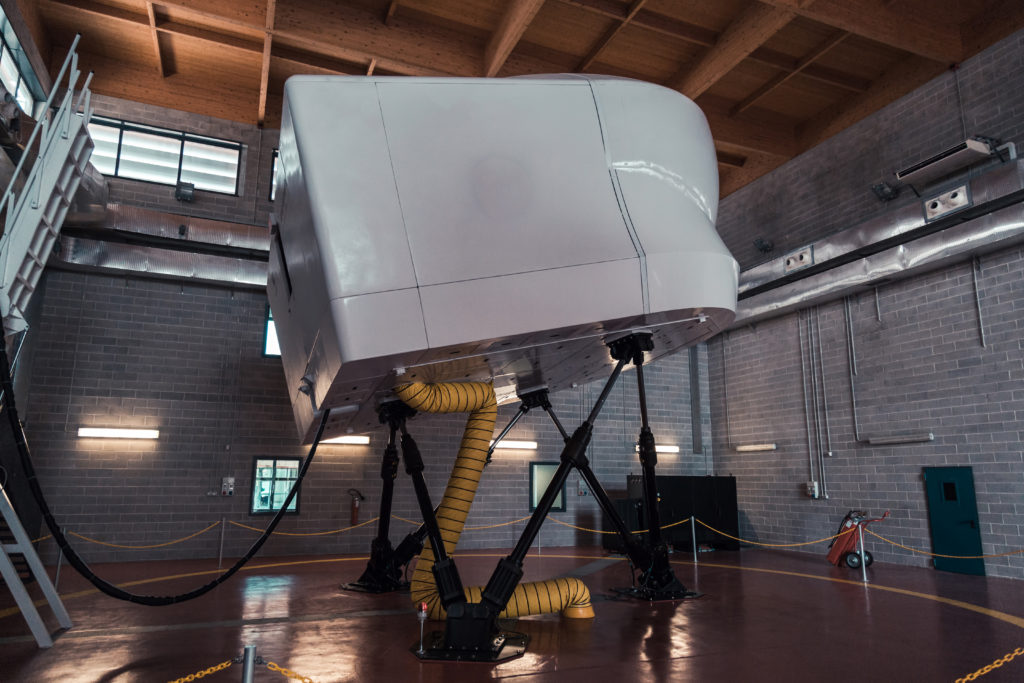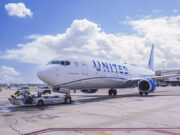
Editor’s note: This is a continuation from Part One, Preparation and training through the oral exam, which was published in the April issue. If you missed it, you can find it hereor within the entire issue from this link. There will be subsequent parts published in future issues to address the challenges of the first year. Please watch this space for more valuable advice for those transitioning from the military or for anyone heading to training with an airline.
Simulator Phase
Once you pass your oral, you can get into the good stuff. The simulator phase can be a lot of fun, but it can also be a lot of work. The keys to success are to start out ahead of the power curve and study with your sim partner. The best way to get ahead is to show up prepared. Knowing your flows (a logical sequence of making your way around the cockpit switches and avionics setup for various phases of flight) and callouts (challenge and response items used to ensure standardization and effective CRM) on the first day of simulator phase will put you ahead of the power curve and allow you to focus on the tidal wave of information and techniques that are about to be thrown at you.
The flows and callouts are detailed in the Aircraft Operating Manual (AOM), and your airline may also provide training videos and other resources to help reinforce the proper flows and callouts. If not, ask around from pilots in classes who started ahead of you and you’ll likely find some great gouge out there on the street.
When you consider that it costs roughly $1000 per hour (or more depending on the aircraft type) to operate a full-motion airline simulator, and you only get so many hours in the simulator before your PC to complete your type rating, you can start to gain an appreciation for why your IP may quickly lose patience with you if you show up unprepared for your simulator sessions. Knowing your flows and callouts will allow you to quickly accomplish your ground operations and get the simulator into the simulated air where it belongs to maximize the efficiency of your training.
Practicing the flows and callouts with your sim partner is the most effective way to study during the simulator phase. Don’t try to go it alone. You need to shift your mindset to the Part 121 crew concept. Studying together and practicing flows, callouts, and avionics setup for various types of approaches will help you to learn from each other and catch each other’s mistakes. Time each other on ground ops flows until you can both meet the standard your IPs expect. Just like military pilot training, mental mission rehearsal (aka chair-flying) will pay huge dividends in the simulator phase of training. With your sim partner, chair-fly each phase of flight and each maneuver listed on the syllabus prior to each simulator ride.

Take Charge of Your Own Training
“Take charge of your own training,” is a phrase we use to preach to our students in Air Force pilot training, and it still applies as an airline pilot in training. During simulator phase, you may notice that the profiles are very busy. That’s because the airline will inevitably try to stuff ten pounds of feces into a five-pound sack, which is to say they have a ridiculously high number of training events you are required to perform in a small number of simulator sessions. There will be a lot of pressure to call each lesson complete so you and your sim partner can move to the next simulator lesson. If you start to feel like you’re getting behind or there is a particular maneuver you’re struggling with, speak up early and ask for help.
We had a pilot in my training class who had a single-engine fighter background. He struggled with the single-engine V1 cut (engine failure at decision speed), and the subsequent single-engine takeoff, pattern, and ILS approach during B-737 qualification training. The large amount of asymmetric thrust and control inputs required in an airline transport category aircraft were unlike anything he had trained for previously in his aviation career.
He confided to me that he knew he was not gaining the required proficiency standard after struggling with the single-engine maneuvers during several simulator sessions in a row, yet his IP kept progressing him to the next lesson with fewer and fewer simulator lessons remaining before the type rating PC. He told me his IP gave very thorough debriefings and answered all his questions, yet he didn’t offer many techniques for correcting his asymmetric thrust controllability issues. Ultimately, his sim partner (who had previous B-737 experience) worked with him after class to help him determine that lack of proper-rudder trim and thrust setting techniques were the root source of his issues. With this help, he was able to pull it all together just in time to pass the PC.
The lesson for you to learn here is that he should have been more assertive and taken charge of his own training. He knew he wasn’t meeting the standard and should have requested an additional simulator session dedicated solely to practicing single-engine maneuvers. It’s hard to admit you’re struggling in fast-paced, high-demand training where much is expected of you. It’s also easy to become complacent and convince yourself that you’re doing “well enough” and they wouldn’t pass you on to the next lesson if you weren’t ready. Let me be clear here, if you start having these thoughts, you are not ready.
Don’t be afraid to speak up and take charge of your own training. The airline wants you to get the best training possible, but they are also under a lot of pressure to produce the number of pilots they need to graduateeach month. Talk to your IP first, and if you still don’t feel like you’re getting what you need, talk to the training manager. Maybe you need a new IP who can offer some different techniques?
The capstone of simulator phase is the PC and the LOE. The PC is the FAA’s blessing that you are qualified to fly every maneuver required to be officially type rated in that aircraft. The LOE is your airline’s blessing that you are ready to be a line pilot first officer. Both the PC and the LOE are jeopardy events that will result in an FAA pink slip if you fail.
The PC is not designed to replicate a typical flight but is a bunch of maneuvers performed in a pseudo-random fashion designed to squeeze all the FAA requirements into a two-hour block with a little bit of slop time left over to repeat any maneuver(s) that didn’t go well on the first attempt. There is a lot of putting the simulator on freeze between events and repositioning for the next maneuver. In the Air Force, we called this type of training, partial-task training, in that it is not designed to reflect a real operational flight but instead focuses on practicing or (in this case) demonstrating proficiency in certain skill sets. The check airman will quickly help you get the cockpit set up, as it would be for that phase of flight in the real world. He/she will give you and your partner a minute or two to brief the approach and then ask if you’re ready to come off freeze.
Everything happens very quickly, and it can be very disorienting with all the freeze, reposition, “Ready? Go!” The key to a successful PC (beyond knowing your procedures to perfection) is to slow down and don’t let them rush you. If you’re not 100% oriented and ready to fly the maneuver, tell the check airman you need another minute to cage your brain. It’s your butt on the line here, not theirs. The other key to success is communication and teamwork with your simulator partner. You are being evaluated not just in the Pilot Flying (PF) role, but also in the Pilot Monitoring (PM) role. For example, don’t be afraid to direct a go-around if that’s what the situation calls for. You are expected to do so as a good PM. If you see flight parameters out of limits, make the callout. Don’t try to hide it because you think the check airman may not have noticed. Trust me, they see everything!
After you pass your PC, you are officially type rated in the aircraft and you get to add that type rating to the backside of your ATP certificate. However, don’t celebrate too much just yet, you still have to pass the LOE. The LOE is designed to replicate a typical line flight. Unlike the PC, there is no freezing the simulator during the LOE. Everything is treated as real starting from the moment you arrive at the simulator until you arrive at the gate at your destination and finish the Parking Checklist. If something occurs during the LOE, you have to react as you would on the line using your crewmembers with other internal and external resources.
They will probably throw you a simple emergency or two during the LOE to see how you handle running the checklists, but more than likely you won’t have to deal with any major, complex emergency scenarios. The LOFT (Line Oriented Flight Training) is oriented more toward seeing how you handle (as a crew) task loading, additive conditions (weather, degraded systems, etc.), and distractions while continuing to accomplish all normal procedures.
There are a few keys to success on the LOE. First, don’t let the scenario rush you into making mistakes. The check airmen, acting as various other ground and flight crew members including flight attendants, operations agent, ground crew, and maintenance personnel, will try to create a sense of urgency to get the jet off the gate on time. Don’t fall for it! Handle each distraction as it happens but don’t push back until you are ready when all flows, briefings, checklists, and paperwork are complete. If that means you push back late, so be it!
The second key to success is learning to balance cockpit task management by either reducing the number of tasks that need to be accomplished and/or creating more time. So, how do you do that? Use your resources! If you are the PF, focus on flying the aircraft as your number one priority. Hand off tasks to others as appropriate for the scenario, “Hey Jim, contact dispatch and have them get us weather for a divert to Birmingham along with fuel required.” The captain will ultimately be responsible for ensuring the plan that dispatch provides makes sense, but at least you’ve bought some time to think by offloading the number of tasks required of the pilots for the moment.
What about creating more time; how can you do that? There are several ways to create time including flying a slower airspeed, asking for holding, requesting extended vectors, and if you’re just not ready to land or the approach is screwed up, go around!
As long as you work well as a crew to safely get the aircraft back on the ground and don’t violate any flight rules or company procedures, you can get away with a lot going wrong with the LOE and still pass. I think our check airman used the LOE as a wake-up call for us that line flying can be very demanding, and we better be ready for anything that gets thrown at us. There is no freeze button in the real world. As one of their pilots, the company is counting on you to do the right thing and speak up when you see something wrong.
Summary
Airline training is intense, but it’s only six to eight weeks long. I could stand on my head in a pile of horse poop for that long if I had to. I may not like it, but I could probably do it. As a military trained aviator, you’ve been through a yearlong training program that was every bit as intense, if not more so, than airline training. You should be able to handle this without much problem.
Hopefully, this article has given you a deeper insight into what you will face in a Part 121 airline-training program. It is intensive training, but certainly not insurmountable. Once you get into a groove, it can even be quite enjoyable, but the way to reach that Zen-training state of mind is to show up prepared and get ahead of the game.
In future articles we’ll address some of the challenges that await you once you get out on the line. Until then, happy landings and blue skies, my friends.






















































